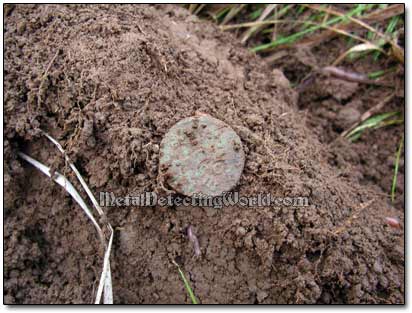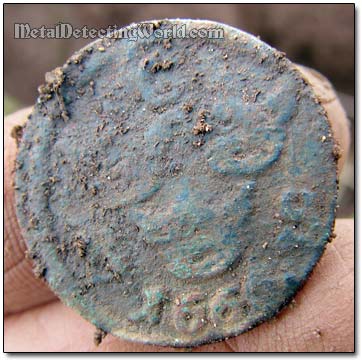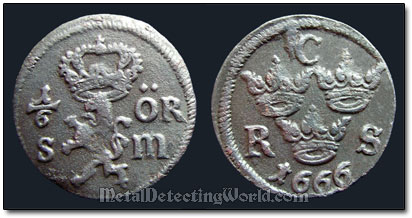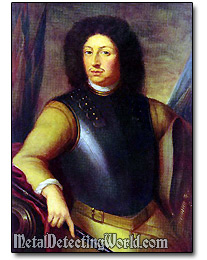Part I - Metal Detecting at the Swedish Tavern Site, page 14
Recovering 1/6 Öre Coins of King Charles XI of Sweden
After expressing our congratulations to Bob, Nikolai and I resumed our search. Nikolai had also recovered a couple of Swedish coins of the same denomination. Theoretically, to be maximum efficient, we should dig up not only the "solid" coin signals, but every "bad" non-iron signal to "fish out" the coins masked by the old and modern iron junk mixed with numerous square nails that were used in building the tavern.
In reality, everybody usually is "taking the cream" until the area is depleted of all good signals. The best thing to do in this situation is to follow the principle: "Do as the Romans do." If you use an advanced metal detector, you can deal with questionable signals later, and your detector would give you a great advantage. So I went picking up just the good coin signals.

This coin was buried at shallow depth as well. What prevented the coins from sinking deeper in the ground over centuries was a layer of flat pieces of limestone lying 7 " deep underneath. Most likely the "horse parking" area around the tavern was paved for the patrons' convenience and to provide a cleaner environment during the wet and muddy seasons.
Presence of the stone layer lying intact under the soil indicated that this part of the field had been undisturbed by annual plowing. It meant that if there was a coin cache buried at this property, it would not be easily found, and a different technique of search would have to be applied for its discovery.
Up Close

Because this coin also had a strong relief and no oxidation, later I easily cleaned it with Ammonia solution and then treated the coin with a Copper Sulphate 5-hydrat/Potassium Permanganate solution to give it a nice appearance (you can read about these methods here: Cleaning Copper Coins and Artificial Patination of Copper Coins).
Swedish 1666 1/6 Öre Coin After Cleaning and Treatment

OBVERSE: 3 Crowns with letters C.R.S. (Charles Rex Sveciae - King Charles of Sweden) and date 1666
REVERSE: Griffin below crown, divide value 1/6 ÖR and abbreviation "s.m." ("silvermynt")
COIN DIAMETER: 26mm
COIN WEIGHT: 7.1g
COMPOSITION: Copper (Cu)
MINT: Avesta
During the reign of Charles XI (Karl XI) no fyrk coins were issued. Instead, 1/6 Öre SM coins were minted in big quantities. This was the first time in the history of Swedish coinage that the amount of copper in coin did not represent the coin value: the coin weight was less than one sixth of 1 Öre SM. The mark "SM" on coins stands for "silvermynt" - "silver coin", which means that this given amount of copper corresponds to a certain amount of silver.
Both silver and copper 1 Öre coins were in circulation at the same time. As the 1/6 Öre SM actually equalled 1/2 Öre KM ("Kopparmynt" - copper coin), the former was called "halvöring". 111,588,096 of the 1/6 Öre coins were minted from 1666 to 1686, including 35,040,000 of the 1666 1/6 Öre coins. One "halvöring" could buy you a pint of light beer at the tavern in the 1660s.

King Charles XI - Brief Historical Facts:
The coin was struck at the Avesta mint during the reign of Charles XI (Swedish: Karl XI) who was King of Sweden from 1660 until his death in 1697, in a turbulent period in Swedish history known as the Swedish empire (1611-1718). Charles was five years old when his father King Charles X of Sweden died, so Charles was educated by his governors until his coronation at the age of seventeen.
Soon after, he was forced out on military expeditions to secure the recently acquired Swedish dominions from the Danes during the Scanian War. After he defeated the Danish troops, he returned to Stockholm and engaged in correcting the country's neglected political, financial and economic situation, managing to sustain peace during the remaining 20 years of his reign.
Changes in finance, commerce, national maritime and land armaments, judicial procedure, church government and education emerged during this period. Charles XI was actually the 5th King Charles. His great-grandfather, King Charles IX of Sweden (1604-1611) adopted his own numeral by using a mythological History of Sweden. The numbering tradition still continues, with the present king of Sweden being Carl XVI Gustaf. Charles XI was succeeded by his only son Charles XII, who made use of the well-trained army in battles throughout Europe.